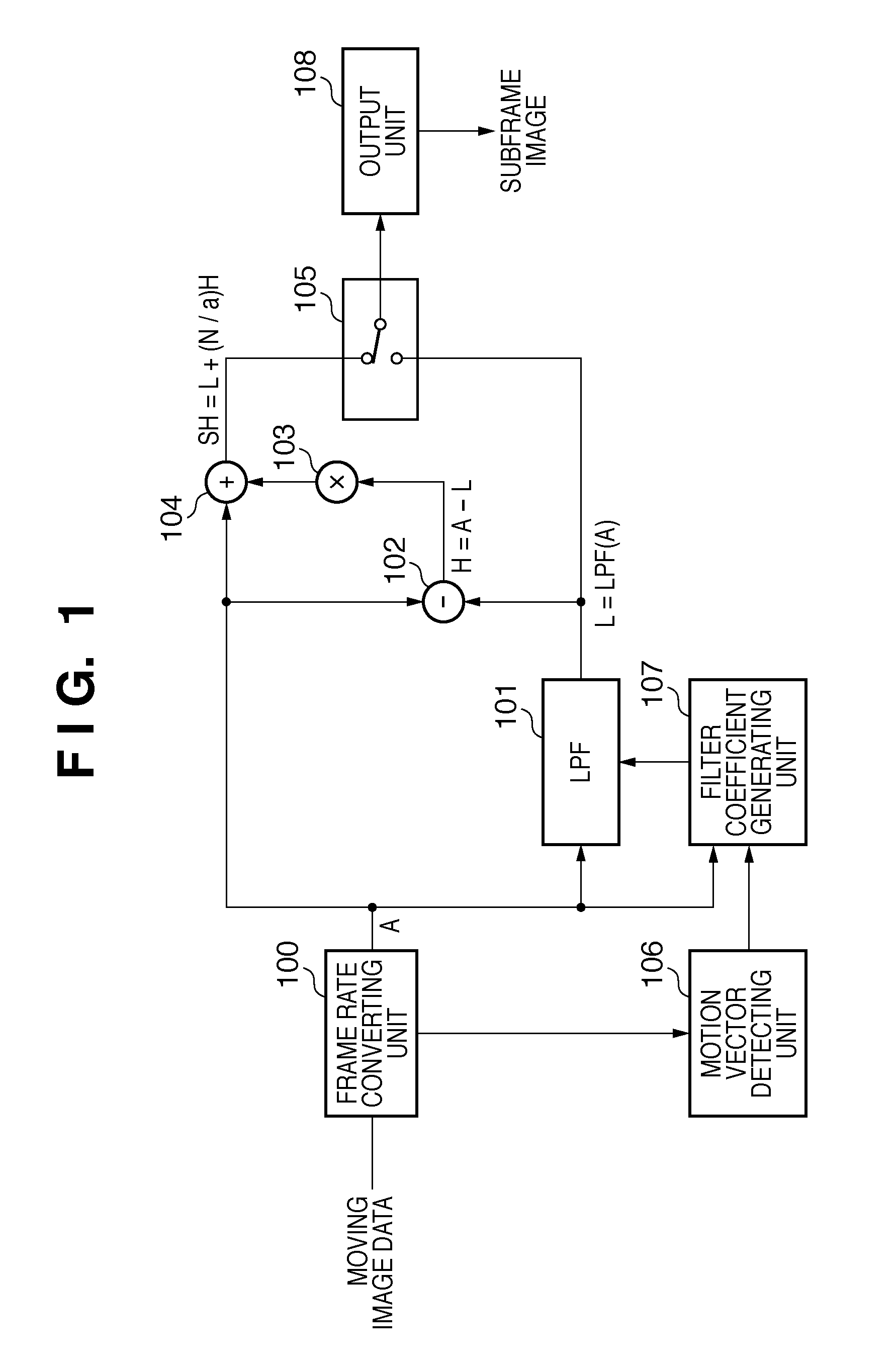Image processing apparatus, image processing method, and storage medium
a technology of image processing and image processing method, applied in the field of image display technique, can solve the problems of large amount of calculation, difficult to observe flicker, and image lag (tail-blurring) in an area, and achieve the effect of reducing image lag in an area
- Summary
- Abstract
- Description
- Claims
- Application Information
AI Technical Summary
Benefits of technology
Problems solved by technology
Method used
Image
Examples
first embodiment
[0033]FIG. 1 is a block diagram showing the arrangement of an image display apparatus according to the first embodiment. Referring to FIG. 1, reference numeral 100 denotes a frame rate converting unit; 101, a low-pass filter (to be referred to as an LPF hereafter); 102, a subtracter; 103, a multiplier; 104, an adder; 105, a switch; 106, a motion vector detecting unit; 107, a filter coefficient generating unit; and 108, an output unit.
[0034]The frame rate converting unit 100 acquires moving image data in one frame unit, and generates N subframe images from one frame image. More specifically, the frame rate converting unit 100 includes a frame memory (not shown), and stores input moving image data as an input image in the frame memory on a frame basis. The frame rate converting unit 100 then generates N subframe images as replicated images by reading one frame image of interest (input image) N times at the N times higher frequency than input video data. Assume that in this case, one s...
second embodiment
[0087]In the first embodiment, the filter coefficient generating unit 107 calculates the coordinates (X, Y) of a reference point according to equations (4). However, the way of obtaining a reference point is not limited to this method. In some cases, the absolute value of each component of a motion vector V(x, y) greatly exceeds the filter size (kernel size) of the filter function. Assume that the absolute value of each component of a motion vector is very large. In this case, when a reference point moves, the filter shape may become unbalanced because, for example, the maximum size of the filter size (kernel size) is limited on a circuit. That the filter shape becomes unbalanced is that, for example, the filter size becomes asymmetric about the center of the filter function in the x direction. It is possible to use the asymmetric function. However, it is also possible to impose a limitation on the moving amount of a reference point.
[0088]In the second embodiment, a limitation may b...
third embodiment
[0092]In the first and second embodiments, the LPF 101 performs spatial frequency component splitting. In the third embodiment, a high-pass filter (to be referred to as an HPF hereinafter) performs spatial frequency component splitting. An HPF may be, for example, a filter function represented by a Laplacian filter which determines filter coefficients based on a spatial second derivative.
[0093]FIG. 12 is a block diagram showing the arrangement of an image display apparatus according to the third embodiment. The same reference numerals as in FIG. 1 denote the same constituent elements as those in the first embodiment. In the third embodiment, the operations of a frame rate converting unit 100, motion vector detecting unit 106, and output unit 108 are the same as those in the first embodiment.
[0094]Unlike in the first embodiment, a filter coefficient generating unit 107 outputs filter coefficient used by an HPF 1201. The filter coefficient generating unit 107 obtains filter coefficien...
PUM
 Login to View More
Login to View More Abstract
Description
Claims
Application Information
 Login to View More
Login to View More - R&D
- Intellectual Property
- Life Sciences
- Materials
- Tech Scout
- Unparalleled Data Quality
- Higher Quality Content
- 60% Fewer Hallucinations
Browse by: Latest US Patents, China's latest patents, Technical Efficacy Thesaurus, Application Domain, Technology Topic, Popular Technical Reports.
© 2025 PatSnap. All rights reserved.Legal|Privacy policy|Modern Slavery Act Transparency Statement|Sitemap|About US| Contact US: help@patsnap.com



